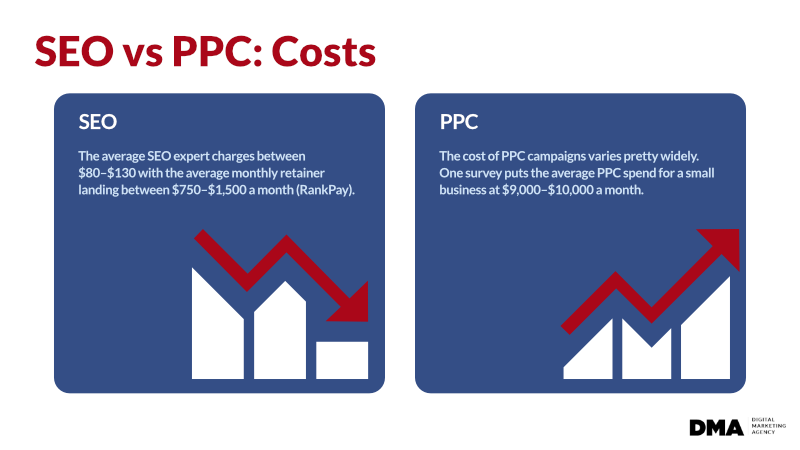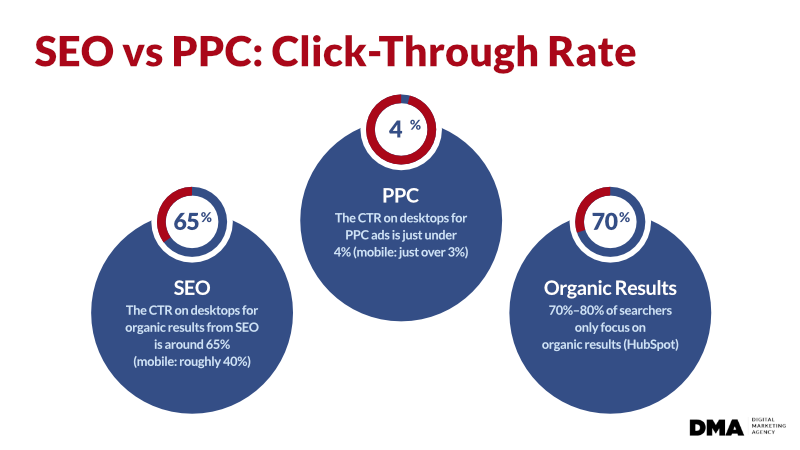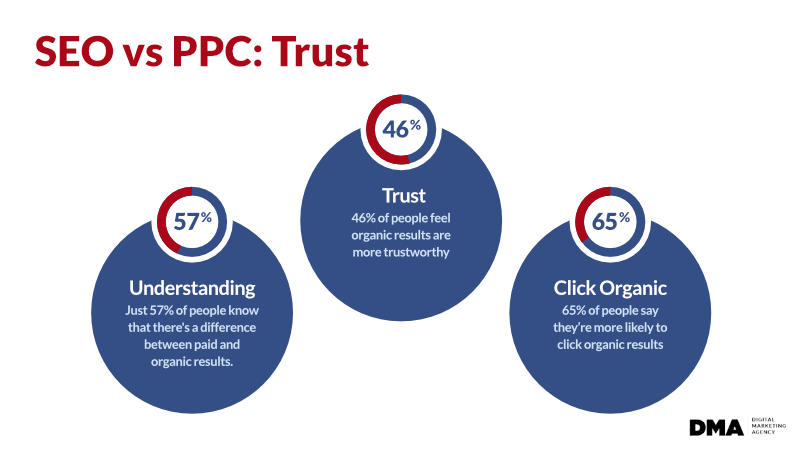SEO
Free SEO Analysis
SEO Services
Content Marketing Services
Local SEO
Link Building Services
Specialized SEO Services
PPC
REPUTATION MANAGEMENT
Free Reputation Management Analysis
Reputation Management Services
Review Management Services
Specialized Reputation Management Services
CEO Reputation Management
Brand Enhancement
Business and Directory Listings
Comprehensive Reputation Management Audit
SOCIAL MEDIA
Free Social Media Analysis
Specialized Social Services
WEB DEVELOPMENT
Free Website Analysis
Web Design Services
Mobile Development Services
Website Maintenance Services
Specialized Development Services
MARKETING AUTOMATION
Free Marketing Automation Analysis
Specialized Marketing Automation Services
Comprehensive Marketing Automation
INDUSTRIES
ABOUT DMA
PPC, SEO
SEO Vs PPC: How to Combine These Marketing Tactics for Better Results
Request a quote
Its Fast, Easy & Free
Executive Summary
- SEO (search engine optimization) is the process of getting free, organic traffic from search results using keywords, search intent, and other on-page and off-page ranking factors.
- PPC (pay-per-click) advertising is the process of buying space on SERPs. Depending on what you pay, this could be the top, bottom, or side of the page.
- While PPC can give you fast results and help you reach a very targeted audience (potentially with a high purchase intent), SEO is much more cost-effective and will bring in more traffic and a better ROI in the long-term.
SEO or PPC? Where should you put your focus? In this article, we’ll take a look at SEO vs. PPC so you can decide what’s right for your business.
Both SEO and PPC are search engine marketing (SEM) tactics that drive traffic to your site, but the types of traffic and the speed with which they work is a bit different.
SEO is a driver of unpaid, organic traffic and that type of traffic makes up the bulk of traffic that makes its way to your site.
Of course, it takes time to get your content to the top of the first page of search engine results (SERPs). Sometimes, it takes a lot of time to make it there. Especially for more competitive keywords where thousands or even millions of pages are vying for those tops spots.
Because of the time it takes to get a business to rank organically in SERPs, many turn to PPC, using paid-per-click ads to boost traffic to their site.
Both PPC and SEO have a place in your marketing plan and many times work together to create a traffic strategy that benefits your brand.
Let’s take a look at what, exactly, SEO and PPC are, take a look at some key differences between them, and even see how you can use SEO and PPC together.
What Is SEO?
SEO (search engine optimization) is the process of getting free, organic traffic from search results using keywords, search intent, and other on-page and off-page ranking factors.
A strong Google presence is so important for your business to succeed. By investing in SEO, you’re creating content that will reach your target audience, driving more traffic to your website where you can use additional marketing tactics to convert that traffic into paying customers.
What Is PPC?
PPC (pay-per-click) advertising is the process of buying space on SERPs. Depending on what you pay, this could be the top, bottom, or side of the page.
PPC results will either show up in a Google shopping carousel or will be designated as ads.
As the name suggests, PPC advertising uses a pay-per-click model. This means that you bid on your ads, telling Google how much you’re willing to pay to be placed highest on the page. You’ll only be charged for the actual clicks on your ad.
SEO vs. PPC
What are the differences and similarities between SEO and PPC? In this section, we’ll take a look at seven different areas to see how each of these SEM tactics performs.
1. Cost

This one should be easy, right? SEO is unpaid! It’s actually a bit more complicated than that. While PPC is paid advertising, SEO requires a lot of resources.
To get the most of your SEO efforts, you’ll need to invest. Whether you hire an in-house SEO expert or an SEO consulting company, you’ll be putting up some money.
The average SEO expert charges between $80–$130 with the average monthly retainer landing between $750–$1,500 a month, according to RankPay.
SEO takes more than just time.
Some business owners believe that PPC costs are easier to control. With PPC, you can set a maximum daily spend. Once you hit that max, Google will stop running your ads.
The downside of that is, if you have a lower budget, you’ll hit your max ad spend too early to get the results you’re looking for. Plus, it’s going to take longer to get the data you need to improve your campaigns.
The cost of PPC campaigns varies pretty widely. One survey puts the average PPC spend for a small business at $9,000–$10,000 a month.
This doesn’t mean, of course, that you’ll definitely be spending that much, but it does signal that an effective PPC campaign requires a big investment.
To better understand the cost differences between these two tactics, check out our article about PPC and SEO cost-effectiveness and value.
2. Control
PPC gives you a lot of control. While there’s a lot you can work on to make your SEO efforts more effective, especially spending your time on creating high-quality, in-depth content, you’re still at the mercy of the Google gods.
Even when you take the time to create SEO titles and write your own meta descriptions to let Google know what your content is about, Google may still decide that they don’t like your title and meta description so they’re going to use their own.
With PPC, you get to focus on specific keywords, letting Google know that these are the keywords you want your ad to show up for. You can even use negative keywords to make sure that your ad does not show up for certain keywords.
You also have the freedom to design your ad to be exactly what you want it to be.
That doesn’t mean that Google doesn’t have guidelines you must follow for your ad copy, images, and formatting.
However, you get to specify who sees your PPC ads and when.
3. Effort
SEO and PPC both take work. This includes keyword research, identifying your target audience, writing, sourcing the right images, and monitoring your results.
Overall, though, SEO is going to take more work.
PPC requires optimizing a single piece of content, maybe two if you create an ad-specific landing page.
But, SEO requires optimizing not only your content but your website itself. Literally every single blog post and page on your site must be optimized from the content to the code.
SEO also requires off-page efforts like link building, social media marketing, guest blogging, brand mentions (linked and non-linked), and influencer marketing.
Plus, SEO requires ongoing effort. It’s not a “set it and forget it” thing. The pages and posts on your site will need to be regularly evaluated for effectiveness and to determine if they’re outdated.
To continue getting the most from the content you already have, you need to be dogged with SEO audits. All while still creating new content… that you’ll then need to monitor and update.
4. Speed
SEO can take months or years before you start getting results from your hard work. And, the likelihood of getting in on competitive keywords is slim, even after several months.
The upside of SEO is that it drives a ton of traffic. Typically a lot more than PPC campaigns.
PPC, though, is a lot faster. You can use it to start building traffic to your site while you’re waiting for your SEO efforts to take off.
5. Click-Through Rate

Click-through rates (CTR) are where SEO really shines.
According to BrightEdge Research, the CTR on desktops for organic results from SEO is around 65% (mobile devices CTR is roughly 40%). When you consider that the CTR for PPC ads is just under 4% (and just over 3% for mobile devices), it’s clear that SEO rankings are ridiculously valuable.
Plus, 70%–80% of searchers only focus on organic results (HubSpot).
6. Trust

It probably shouldn’t come as a surprise that more people trust organic results that rank highly more than the ads that pay to be in those top spots.
But that’s only based on the approximately 57% of people who know that there’s a difference between paid and organic results in the first place.
Still, when you consider that 46% of people feel organic results are more trustworthy, and 65% say they’re more likely to click organic results, it’s clear that SEO is a much better investment if you’re interested in building trust for your brand.
7. Analytics
If you’re not paying attention to your analytics, you’re not getting as much as you could from any of your marketing efforts.
Analytics give you the data that you need to understand how your marketing is performing, but also provides insights into things you can do to make your marketing return even better.
For SEO, your analytics will give you important information like:
The amount of traffic that comes from organic search
What pages on your site perform that best
Where you rank for your target keywords
Using that information, you can duplicate efforts that are performing well and either tweak or scrap those that aren’t.
Analytics are also great for PPC.
Not only will you be able to find out which of your ads are performing the best, you can also use the data to help you create A/B split tests so you can make your ads better. Take a look at this article for things to consider when assessing your PPC campaigns.
There are many free and paid analytics tools that you can use, but we recommend Google Analytics. It’s both free and powerful and can provide granular data you can use to get results from both organic and paid search efforts.
Using SEO and PPC Together
As you can see, SEO and PPC aren’t necessarily an either/or as much as they are a duo that will help you boost traffic, increase sales, and meet your marketing goals.
That said, we’ve also shown you that these SEM tactics each have strengths and weaknesses.
That’s why we recommend using them together for the best marketing results.
In this section, we’re going to explore six different goals you may have and how your brand might benefit from SEO or PPC.
1. Brand Awareness
If you’re looking for a way to build brand awareness fast, PPC is going to be your best bet.
While you’ll be able to drive traffic just from PPC, the real benefit is what happens in searchers’ minds as they continue to see your PPC ads.
Paid search will get your content—and your name—showing up at the top of the SERPs and over time, this will lead to brand recall.
Improved brand recall means that more people are going to recognize your brand, even if they’re not sure where they first learned about you. This recall is what will drive searchers to eventually click on your organic results.
2. Local Leads
If you’re a brick-and-mortar business or even an online business that wants to gain a foothold in a particular geographic area, local leads matter.
When searchers search for local businesses using “near me” searches, PPC ads show up first, followed by Google My Business listings. When you leverage local PPC ads along with an optimized Google My Business profile, this can mean that your business shows up twice within the first handful of results!
3. Targeting
PPC lets you fine-tune your target audience in a way that SEO just doesn’t. You can set up PPC ads to show up for certain keywords, not show up for others, and even target searchers based on demographics like age, interests, location, and more.
4. Visibility
This goes hand-in-hand with brand awareness. The more often your business shows up in the search results, the higher your chances of getting clicked.
Using a combination of PPC and SEO gives you multiple opportunities to get your content and brand noticed.
5. Brand Image
How do people feel about your brand? Marketing and PR work together to get your brand noticed in a positive way.
Using a combination of SEO and PPC makes it easier to control your brand’s narrative.
6. Testing
Testing can help you figure out what resonates with your target audience.
It’s important to test both your SEO and PPC efforts. Testing basically just means creating experiments in which you test different aspects of your SEO or PPC campaigns to see what happens.
Does your experiment perform better than your control? Great! You just learned something about the way your audience interacts with your brand.
For both SEO and PPC, you can test headlines, images, colors, copy—every aspect of whatever content you’re using.
How to Use SEO and PPC Together
Over the course of this article, it’s probably become clear that we believe strongly in using a combination of SEO and PPC. How you put these SEM tactics together, though, will make a big difference in the results you get.
There are three elements to consider when you’re trying to create a marketing plan that includes both SEO and PPC.
1. Budgeting
No matter your budget, you should be spending some money on PPC. However, it’s important to understand that you need to spend enough money on PPC to get a return. Otherwise, you’re just wasting money.
This requires an adjustment period where you start with your minimum budget and continue increasing your budget until you hit the point where you’re getting a return.
Of course, if you’re focusing on long-term marketing efforts, you should invest more in SEO and organic search.
2. Planning
How will you leverage PPC and SEO? How long you’ve been in business makes a difference.
Brands that have been around for a while typically enjoy some level of brand recognition.
This means that you can focus the bulk of your efforts on a long-term SEO strategy.
3. Optimizing
Keywords are important for both SEM and PPC, so it’s important to spend the time on optimization.
Optimizing your content and ads for keywords involves using your analytics data to find out what’s working and what isn’t, then taking that information and actually doing something with it.
Conclusion
SEO and PPC are both powerful SEM tactics that can help you drive traffic and boost sales. Each brings its own benefits and weaknesses to your marketing efforts and using these tactics to their full potential takes a lot of planning and analysis.
While PPC can give you fast results and help you reach a very targeted audience (potentially with a high purchase intent), SEO is much more cost-effective and will bring in more traffic and a better ROI in the long-term.
To get the most out of your SEO and PPC efforts, contact Digital Marketing Agency. We offer both SEO and PPC services that will get you more traffic and conversions.
Our Sales team